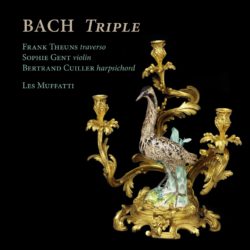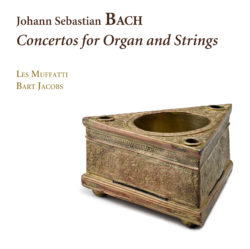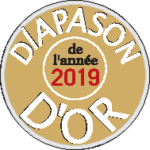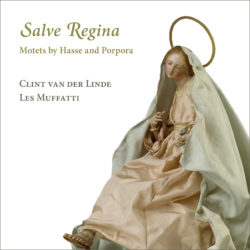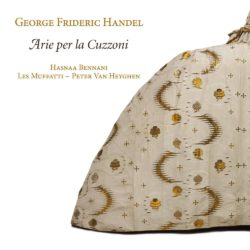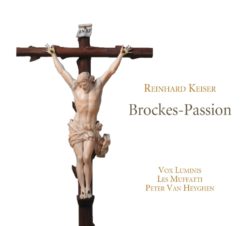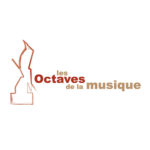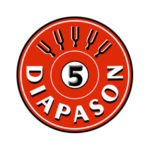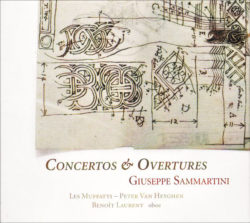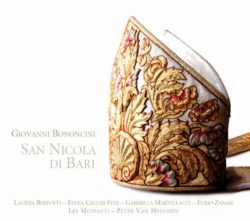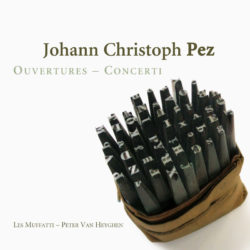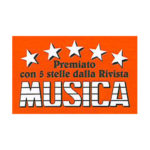If you would like to buy one or more of our CDs, please send us a message at info@lesmuffatti.be with the details of your order, your name and address.
All our CDs are available at 18€ (per single CD) or 23€ (per double CD) + postage & handling. Free shipping across Europe for 3 or more CDs.- Ramée (Outhere Music) - RAM 2301 - 2024
Johann Sebastian Bach, Bach Triple
Les MuffattiTraverso Frank Theuns | Violin Sophie Gent | Harpsichord Bertrand CuillerThree instruments, three emblematic works, and three excellent soloists! With Sophie Gent on violin, Frank Theuns on traverso and Bertrand Cuiller on harpsichord, Les Muffatti offer a fresh interpretation of Bach's Triple Concerto, the Fifth Brandenburg Concerto and the Orchestral Suite in B minor. They provide a variety of orchestral textures, appropriate to the more soloistic style in the Brandenburg Concerto, and the alternating...
ripieno-tutti settings in the Triple Concerto and the Suite. While the Fifth Brandenburg Concerto was composed during Bach's time in Köthen and can be regarded as the first piano concerto ever written, the other two works date from his later years in Leipzig. In these works, Bach exploits the full range of compositional possibilities he had acquired during his lifetime; the highly individual combination of contrapuntal artistry and heightened expressiveness already points to the works composed in the last years of his life. Les Muffatti have been one of the leading artists on the Ramée label from its beginnings; this, their tenth album for Ramée, also marks the label’s 20th anniversary.
With the support of
Ramée (Outhere Music) - RAM 1804 - 2019Johann Sebastian BACH, Concertos for Organ and Strings
Les MuffattiOrgan Bart JacobsAlthough we know of at least five concertos J.S. Bach wrote for solo organ we have no surviving Bach organ concertos with orchestral accompaniment. Contrast this with the 200+ cantatas: of these, 18 feature organ obbligato, which Bach uses as a solo instrument in arias, choral sections and sinfonias. The most obviously conspicuous date to 1726. In May to November of that year, Bach...
composed six cantatas which assign a prominent solo role to the organ. Most of these are reworkings of movements of lost violin and oboe concertos written in Bach’s time at Weimar and Köthen. Why Bach wrote such a number of obbligato organ cantatas in such a short period remains unknown. One possible explanation may lie in Dresden, where Bach had given a concert on the new Silbermann organ in the Sophienkirche in 1725. Some scholars think that, in addition to other organ works, he also performed organ concertos, or at least a few earlier versions of the sinfonias, with obbligato organ and strings in order to show off the organ. From the cantatas mentioned above, along with the related violin and harpsichord concertos, it is perfectly possible to reconstruct a number of three-movement organ concertos of this type. By using this method, we hope to bring some of the music which Bach may have performed in Dresden in 1725 back to life on this CD.
With the support of
Prix
Ramée (Outhere Music) - RAM 2102 - 2019Nicola Antonio PORPORA, Johann Adolf HASSE, Antonio VIVALDI, Salve Regina : Motets
Les MuffattiCountertenor Clint van der LindeNaples was in the mid-18th century the third largest European city and one of the greatest centres of political, commercial and cultural influence. The conservatoires there were founded by religious orders and were originally intended as charitable institutions for the accommodation and education of orphans, but soon became real centres of musical education and performance; many leading composers were pupils and teachers there and...
so contributed to the founding of the Neapolitan School. Porpora and Hasse are the greatest representatives of the Neapolitan style and both settled in Venice before rising to international fame. Their writing was strongly influenced by opera and reflects the Italian taste of the time; it is also present in their religious compositions. Les Muffatti and the South-African countertenor Clint van der Linde present works of exceptional expressive power, with Hasse’s Hostes Averni and Porpora’s Nisi Dominus being recorded here for the first time.
With the support of
Ramée - RAM 1501 - 2015George Frideric HANDEL, Arie Per La Cuzzoni
Les MuffattiDirection Peter Van HeyghenSoprano Hasnaa BennaniBy all accounts Francesca Cuzzoni was short, squat, and hardly a proverbial beauty. Her acting was indifferent, her dress sense poor, and playing the diva was a temptation she could never quite resist. But as soon as she began to sing, her wonderful voice, flawless intonation, and exquisite taste went straight to her audience’s heart. And that was how, on the 12th of January...
1723, aged 26, the young soprano from Parma won the undying love of London’s opera-goers with her performance in the première of Handel’s Ottone. When we started thinking about putting together a programme featuring Hasnaa Bennani, we were struck by how closely the description of Cuzzoni’s qualities as a singer matches Hasnaa’s voice. Both have the same warmth, intensity, and trueness of tone.
With the support of
Prix
Ramée - ram 1303 (2 CD) - 2013Reinhard KEISER, Brockes-Passion
Vox Luminis - Les MuffattiDirection Peter Van Heyghensoprano Zsuzsi Tóth | tenor Jan Van Elsacker | basse Peter KooijThe Brockes-Passion can be considered the archetype of the German Passion oratorio. As such, it served as a model and source of inspiration for famous later masterpieces, enjoying uninterrupted popularity throughout the XVIIIth century when no less than 11 composers, including Handel and Telemann, set it to music. The superb version by Reinhard Keiser (1674-1739) is not only the first but also adheres most closely to the...
great rhetorical power and rich changes of affects of the poet’s text. In German literary history, Barthold Heinrich Brockes (1680-1747) is known above all for his innovative role during the second quarter of the XVIIth century century. In 1712, the year of the Brockes-Passion's first performance, Keiser, fellow citizen of Brockes in Hamburg, was already recognized as the most important opera comp oser in Germany – and, in some opinions, even in Europe. When the genius of these two great artists combined in a single work, the result could only be spectacular. The tricentennial of its first performance justified a belated but nonetheless dithyrambic tribute, here presented by the singers of the Vox Luminis ensemble and the instrumentalists of Les Muffatti.
Extract
- Aria (Tochter Zion) :
With the support of
Prix
Ramée - ram 1202 - 2012Jean-Marie LECLAIR, Violin Concertos Op. 7
Les MuffattiDirection Peter Van HeyghenViolin Luis Otavio Santos
Few French musicians of the 18th century were as appreciated, admired and hailed during their lifetime as was the virtuoso violinist from Lyons Jean?Marie Leclair. In 1753, he was described in Mercure de France as 'the most famous artist that France has had for purely instrumental music'. Three years after his tragic death – he was murdered in 1764 by a jealous nephew...
–, Charles Henry de Blainville remembered him as 'the Corelli of France', where he was thus celebrated up until the early 19th century. In 1754, Friedrich Wilhelm Marpurg placed Leclair on the level of Telemann, Handel and members of the Bach family in terms of harmony and counterpoint; and for Francesco Galeazzi, he was, in 1790, the sole Frenchman on the list of principal masters of the violin in 18th?century Europe, alongside such major names as Corelli, Vivaldi, Somis, Locatelli, Geminiani, Tartini and Stamitz. The Opus 7 concertos can thus be considered the crowning achievement and a sublime summary of Leclair's talents as a virtuoso and composer, one of the greatest of his era. Fireworks of wit and virtuosity, with the brilliant violinist Luis Otavio Santos (Diapason d'Or for his album of Leclair Sonatas released by Ramée) and Les Muffatti, under the magic wand of Peter Van Heyghen.
Extract
- Allegro moderato :
With the support of
Prix
Ramée - ram 1008 - 2011Giuseppe SAMMARTINI, Concertos & Overtures
Les MuffattiDirection Peter Van HeyghenOboe Benoît LaurentDuring his own lifetime, Sammartini was considered to be one of the most talented composers of his generation. John Hawkins wrote in 1776: "His singularities can only be ascribed to that boldness and self-possession which are ever the concomitants of genius." He ranked Sammartini’s concertos and overtures at the same level as those of Arcangelo Corelli and Francesco Geminiani – and even held them...
in higher esteem than Georg Frideric Handel’s. Yet, through an inexplicable twist of history, Sammartini has remained an unknown quantity for the general public. Les Muffatti have made a careful selection from among the plethora of Sammartini’s masterworks in order to fully reflect their quality. They hope that this world-première recording of works in Sammartini’s widely varying styles can do justice to this genius, and share the ensemble’s enthusiasm for this unjustly underrated composer.
Extract
- Spiritoso :
- Allegro Assai :
With the support of
Ramée - ram 0806 - 2008Giovanni BONONCINI, San Nicola di Bari
Les MuffattiDirection Peter Van HeyghenSoprano Lavinia Bertotti | Alto Gabriella Martellacci | Soprano Elena Cecchi Fedi | Bass Furio ZanasiWhen Giovanni Bononcini composed his oratorio San Nicola di Bari he was barely 21 years old. Having entered the service of Filippo Colonna, an important Roman nobleman, Bononcini met the 27-year old librettist Silvio Stampiglia, with whom he rapidly began a fruitful collaboration: in six years (1691-1697) they produced six serenades and five operas in addition to this one oratorio. With no fewer than five performances...
before 1721, San Nicola di Bari was undoubtedly the most successful of Bononcini’s seven extant oratorios. The choice of the subject for the libretto has obvious connections with the nobiliary titles and functions of the commissioner. Filippo Colonna was commander in chief of the kingdom of Naples, and his wife was the sister of the Spanish ambassador in Rome and later Viceroy of Naples. Within the kingdom, which itself depended on the Spanish crown, Bari was the most important port on the Adriatic coast. Somewhat against all expectations, the libretto of this oratorio does not deal with any of the famous miracles of the saint, but it focuses on the young Saint Nicholas, his parents Epifanio and Giovanna and his fellow-student Clitio. In this typically Counter-reformation libretto, the central idea is the saving of the childrens’ souls through their pious and exemplary youth and through absolute obedience to their parents. Stylistically, San Nicola di Bari — composed in 1693, and the only oratorio dedicated to the patron saint of little children — presents very few differences from the previous and conceptually somewhat larger oratorio La Maddalena a’ piedi di Cristo (1690). It offers a similar kind of dignity and vocality, and the same rich and deeply colored harmony. However, the themes of the arias in San Nicola di Bari are yet more fascinating, the alternation between orchestra and continuo slightly more balanced, the contrasts between the emotions more pronounced, and the dialogues in the recitatives even more flexible — the last characteristic probably due to Stampiglia’s more lighthearted libretto.
Extract
- :
With the support of
Prix
Ramée - ram 0705 - 2007Johann Christoph PEZ, Ouvertures — Concerti
Les MuffattiDirection Peter Van HeyghenCD intégralement consacré à Johann Christoph Pez, compositeur de la fin du XVIIe siècle et champion comme Georg Muffat du Vermischter Geschmack, synthèse des goûts italiens et français dominant alors l'esthétique musicale européenne. L'enregistrement propose un éventail très varié de ses compositions instrumentales, illustrant toutes les formes à la disposition du compositeur : concerti, suites, sonates, traitées pour ensemble avec ou sans vents et avec ou...
sans solistes. Ces œuvres d'une étonnante beauté, redécouvertes par Peter Van Heyghen sous forme manuscrite, notamment aux bibliothèques de Rostock et de Dresden, ont récemment fait l'objet, par le chef des Muffatti, d'une édition minutieuse.
Extract
- Allemande :
With the support of
Prix
Ramée - ram 0502 - 2005Georg MUFFAT, Armonico tributo
Les MuffattiDirection Peter Van HeyghenAnyone, whether musicologist, performer, or simply music lover, who has even slightly immersed himself in Georg Muffat's work, eventually comes to the realisation that in today's music culture, Muffat has not been awarded the honorable recognition which he actually deserves. His merits in the fields of composition and education are generally acknowledged in musicological literature, but for the time being, he still remains in...
the shadows of his really »great« contemporaries such as Jean-Baptiste Lully, Arcangelo Corelli or Heinrich Ignaz Franz Biber. This lack of recognition is perhaps attributed to the fact that very little of Muffat's work has been preserved and from that almost exclusively instrumental music. His compositions and related performance practice are comprised of at least three different styles and traditions. This was by no means a coincidence, rather conversely it represented the central point of Muffat's personal aesthetic goal. This, along with the fact that he was one of the first who so emphatically and continually strived for and masterfully realized this goal, is category as the great composers.
Extract
- Armonico Tributo :
With the support of
Prix

